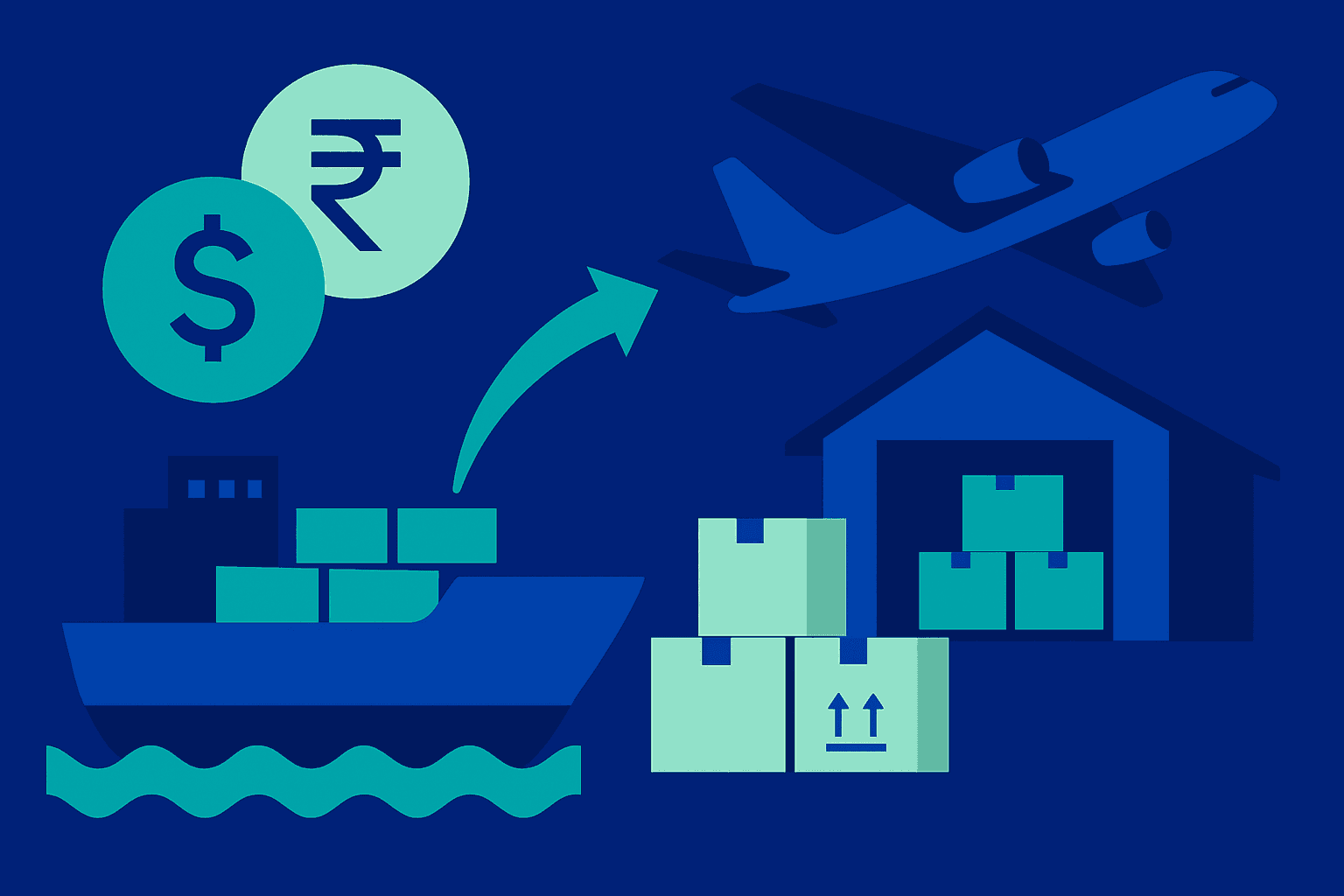Amazon UAE for Indian Sellers (2025): Start, Scale & Get Paid

Picture this: you're selling successfully on Amazon India, maybe you've even started exploring the US marketplace, but recent tariff changes have you worried about putting all your eggs in one basket.
Sound familiar? You're not alone.
More and more Indian sellers are now looking at Amazon UAE (Amazon.ae, often called “Amazon Dubai”) as their next move, and for good reason.
Dubai’s market offers something unique: a growing customer base that actually spends money, shorter shipping distances from India, and English-language listings that avoid translation headaches. For an Indian Amazon seller, the UAE can be a natural extension of what you already do in India and the US.
If you've been wondering whether selling on Amazon UAE is a good fit for your business in 2025, let's walk through what you need to know.
Why Amazon UAE now (post-US tariff hedge)
You’ve built a decent Amazon US business, but every time there’s trade policy noise or tariff talk, you’re refreshing news sites, wondering if your margins just disappeared. That anxiety isn’t sustainable.
Demand and AOV
UAE shoppers spend significantly more per order than many other markets, with the average order value reaching around $102 in 2024, compared to the global ecommerce average of $116.
While the UAE’s AOV is close to the global benchmark, it’s notably higher than the broader MENA region average of $35.60, reflecting strong purchasing power in the Middle East market — a good sign if you want to sell on Amazon UAE with mid-ticket products.
Proximity and cost
Shipping from Mumbai or Delhi to Dubai takes 3–5 days, not 2–3 weeks. Returns don’t eat into margins as much as US returns do. When a customer changes their mind, you’re not staring at a $40 return shipping bill for a $25 product.
Risk diversification
If you’re heavily US-focused right now, one tariff announcement or policy shift can tank your month. Adding Amazon UAE / Amazon Dubai gives you steadier cash flow: when one market dips, the other might hold.
It’s not about abandoning the US; it’s about not being completely dependent on it when trade winds shift.
What sells on Amazon UAE (and Amazon Dubai)
You’re not guessing what might work — you’re filtering for what’s already working on Amazon UAE, then finding your entry point.
The 4-signal filter
For any product you’re evaluating on Amazon.ae:
- BSR trend over 30 days Steady or climbing = consistent demand.
- Review velocity 5–10 new reviews monthly = active buying.
- FBA share above 60% Means the category can support fulfillment costs.
- Price stability Wild swings = race-to-bottom hell.
If a product passes all four, it’s worth deeper digging for Amazon UAE.
Your competitive sweet spot
Look for products that:
- Have under 1,000 reviews
- Are priced between $15–$60
- Weigh less than 1.5 kg
This is where you’re not fighting entrenched giants, margins survive shipping costs, and you can actually win on page one without burning cash on ads, whether you’re on Amazon India, US or Amazon UAE.
Category hunting playbook
Categories that work well for Indian sellers on Amazon.ae:
- Electronics accessories (phone cases, chargers, cables)
- Beauty and Fragrance (serums, tools, not heavy colour cosmetics to start)
- Home & Kitchen (organisers, small appliances)
- Toys and Hobbies (educational kits, collectables)
- Auto accessories (dash cams, organisers)
- Fashion basics (activewear, modest wear staples)
These categories:
- Move quickly
- Don’t require heavy localisation
- Already have strong Indian supplier ecosystems
If you Google “Amazon seller UAE”, these are often the types of products you’ll see dominating.
Localise smart for Amazon UAE
Electricals are where many new Amazon UAE sellers get burnt.
- India uses 230V with Type C, D and M plugs.
- The UAE uses 220V with UK-style Type G plugs (three-pin rectangular).
If you’re selling electronics or appliances on Amazon.ae:
- Your product must work with UAE voltage and plug type or
- You need to clearly state that an adapter is required.
Listing a product that doesn’t meet UAE standards without disclosing this upfront leads to returns and negative reviews — and makes it harder to scale when you sell on Amazon UAE long term.
How to sell on Amazon UAE from India: setup checklist
You’ve decided the UAE makes sense. Here’s what actually needs to happen before your first order lands.
Step 1: Account setup
- Log in to Amazon Global Selling, and add Amazon.ae as a marketplace. If you’re already selling on Amazon India or the US, this takes ~20 minutes.
- New seller? The process asks for business verification upfront — plan for 2–3 days of back-and-forth.
Step 2: Business documents
Have these ready:
- PAN card
- Import Export Code (IEC)
- Bank account details with SWIFT for international payments
If you have Brand Registry on other marketplaces, apply for Amazon UAE too — it unlocks A+ Content and better protection against hijackers.
Step 3: VAT (UAE’s 5% tax)
Whether you need to register depends on your fulfillment model and expected volume.
If required:
- Obtain your Tax Registration Number (TRN)
- Add it in Seller Central under Tax settings
- Maintain proper VAT invoices
This isn’t optional bureaucracy. The UAE takes VAT compliance seriously, and missing documentation can freeze your payouts — which hurts more when those payouts come from a newer market like Amazon Dubai.
Step 4: Listings that work in the UAE
Keep English primary, but layer in Arabic the smart way.
- Add Arabic keywords in your bullet points (keep English as the main language).
- Don’t just Google Translate your listing.
- Check competitor bullets to see what Arabic terms are actually used.
Examples:
- For wireless headphones, top sellers use: “سماعات بلوتوث لاسلكية” (wireless Bluetooth headphones)
- For phone cases, competitors use: “جراب هاتف” (phone cover) more commonly than other variations.
Copy what’s already working in your category — UAE buyers search using these established terms whether they’re on mobile or desktop.
FBA UAE vs MFN (which to use when)
You don’t have to pick one forever. Most smart Amazon UAE sellers use both, just for different SKUs.
FBA UAE
You:
- Ship inventory to Amazon’s UAE warehouse
- Amazon handles storage, packing, delivery, returns
You get the Prime badge, which matters — UAE customers expect fast delivery and trust Prime.
Best suited for:
- Small, lightweight products
- SKUs that sell consistently
Watch out: if something sits for 90+ days, you’re paying storage fees that quickly eat into margins.
MFN (Merchant Fulfilled Network)
You:
- Fulfil orders yourself from India or a third-party warehouse
- Have no storage fees
- Control packaging (useful for brand experience)
- Decide shipping speed
MFN is ideal for:
- Test SKUs where demand is uncertain
- Oversized or heavy items with high FBA fees
- Seasonal products that spike and then go quiet for months
A hybrid approach that works
- Launch new products as MFN.
- If something consistently sells 20–30 units/month for two consecutive months, consider moving it to FBA UAE.
Your winners get Prime eligibility; your experiments stay lean. When that seasonal spike hits — Diwali gifting, Ramadan demand — you can flex back to MFN to avoid long-term storage costs on inventory that won’t move again for six months.
Shipping and landed cost math for Amazon UAE
Before listing a product at AED 99 and hoping it works out, run the actual numbers. Surprises after your first sale are expensive.
INR → AED unit economics
- Start with your ex-factory COGS in INR What you pay the manufacturer before shipping, taxes, or additional costs.
- Add: International freight (air vs sea can differ by 40%+) Customs duty (varies by HS code — electronics often ~5%, textiles 0–10%) Clearance charges FBA or MFN fulfillment fees VAT on the taxable value (product price minus exempt components)
- International freight (air vs sea can differ by 40%+)
- Customs duty (varies by HS code — electronics often ~5%, textiles 0–10%)
- Clearance charges
- FBA or MFN fulfillment fees
- VAT on the taxable value (product price minus exempt components)
- Convert everything to AED
What’s left is your real margin, not the fantasy number you calculated by only looking at COGS and selling price.
Margin guardrails
You want a minimum 25–30% margin after all fees to cover:
- Ad costs
- Returns
- Occasional customs delays
If FBA fees push you below that:
- Raise your price or
- Switch that SKU to MFN
At 15% margin, it’s tempting to think more sales will make up for it. In reality, thin margins mean you’re losing money faster. Fix the pricing or fulfillment model now instead of letting the problem scale across Amazon UAE.
Prep essentials
- Fragile products need poly-bagging or foam inserts so they survive to the FBA warehouse.
- Some categories require Arabic labels (cosmetics, food items, certain electronics). Check category requirements before your first shipment.
A rejected shipment sitting at customs because of missing Arabic compliance labels costs more than just printing the right sticker upfront.
Pricing and promotion for Amazon.ae
Pricing isn’t just converting your India price to AED and calling it done. The math needs room for reality.
List in AED with buffers
Your price must:
- Account for currency fluctuations (INR–AED can swing 3–5% in a quarter)
- Include the 5% VAT added at checkout
If you price at exact cost plus 20% and the rupee weakens, you’re suddenly underwater.
Build a 5–8% FX buffer into your base price so you’re not repricing every month when exchange rates move.
Promotion timing that matches UAE demand
UAE buying patterns differ from India and the US:
- Ramadan and Eid are massive — Diwali-level spending in compressed weeks.
- Back-to-School: August–September.
- Dubai Shopping Festival: January–February with citywide discounts expected.
Running a 10–15% coupon during these windows isn’t generosity — it’s table stakes where customers are already shopping heavily on Amazon UAE / Amazon Dubai.
Outside these peaks, your regular price needs to hold without constant discounting.
Ads that don’t burn cash
Start simple:
- Launch Auto campaigns set to Close Match.
- Let them run for 2–3 weeks.
- Pull the search term report.
- Migrate converting terms to Exact match campaigns with tighter bids.
Don’t forget Arabic keyword match types for your core 5–10 terms. Even if your listing is primarily English, UAE customers search in both languages.
Getting paid from Amazon UAE (India-friendly, export-grade)
Amazon will pay out to your bank account — but getting that AED into usable INR without losing chunks to fees is where most sellers mess up when they sell on Amazon UAE.
The problem
You have a few options for receiving Amazon UAE payouts:
- Amazon Currency Converter (ACC)
- Third-party payment platforms
- Direct bank transfers via SWIFT
The issues:
- ACC: convenient, but 3–4% conversion markup above market rates. On a ₹10 lakh payout, that’s ₹30,000–40,000 gone.
- Traditional SWIFT transfers via banks: Hidden FX spreads (often 2–3% worse than market rates) + intermediary bank fees.
- Third-party platforms: pricing and reliability vary widely.
On top of that, your bank will ask for export documentation — FIRA forms, eBRC certificates — and if you’re handling this manually for every payout, it’s hours of back-and-forth with your CA to prove the money is legitimate export earnings from Amazon.ae.
The Skydo solution
Skydo gives you UAE virtual accounts that receive Amazon’s AED payouts directly.
- You see the live forex rate when converting to INR — no hidden spreads eating your margin.
- Instant FIRA generation and automated eBRC mapping for each payout.
- Cleaner reconciliation and accurate visibility into what hits your Indian bank.
Your finance team isn’t chasing paperwork, you’re not guessing why a payout is ₹15,000 short, and you know exactly how much you can reinvest in inventory or marketing.
Predictability matters when you’re scaling on Amazon India, US and Amazon UAE at the same time.
Compliance and paperwork (don’t skip)
This isn’t exciting, but skipping it means frozen payouts or RBI notices months later — usually right when your Amazon UAE sales start compounding.
Keep everything
Maintain:
- Commercial invoices
- Shipping documents
- Customs duty payment proofs
- VAT filings with your TRN
- Amazon payout statements
- FIRA forms
- eBRC certificates
When your CA requests export documentation during tax season, or if the RBI audits your foreign inflows, you’ll need these documents ready.
“I’ll find it later” often becomes “I’m paying penalties now.”
RBI purpose codes matter
Every inward remittance needs the correct P-purpose code.
For Amazon sales, a lot of the payments may have P0102 (export of goods). However, please confirm the exact purpose code from your bank, CA or payments partner.
Wrong code = your bank flags the transaction, and fixing it means forms, delays, and long explanations of what you’re actually doing.
Get it right the first time.
Fast start: 30-day action plan to sell on Amazon UAE
You’ve read enough. Here’s what the first 30 days look like if you start now.
Week 1
- Run the 4-signal filter on 20–30 potential products on Amazon.ae — BSR trend, review velocity, FBA share, price stability.
- Pick your best 10 SKUs.
- Log in to Amazon Global Selling and add the Amazon.ae marketplace to your account.
- Start your VAT registration process if your model requires it (approvals take time).
Week 2
- Localise those 10 listings: English primary Arabic terms taken from competitor bullets (not guesswork)
- English primary
- Arabic terms taken from competitor bullets (not guesswork)
- Get your FBA inbound shipping labels ready, even if you start MFN.
- Price in AED with your FX buffer and VAT included.
- Fix images now: voltage specs visible, plug type clearly shown, region-appropriate lifestyle pics for Amazon UAE / Amazon Dubai.
Week 3
- Launch your first products as MFN. Orders will trickle in — that’s fine, you’re testing demand without committing warehouse space.
- Start Auto ad campaigns with Close Match for your top 5 SKUs.
- Prepare your FBA shipment for the three SKUs showing the most consistent sales.
- If nothing is moving after 10 days, revisit pricing, images, or listing quality before going further.
Week 4
- Turn on FBA UAE for your proven winners.
- Connect your Skydo UAE virtual account so payouts flow smoothly without manual paperwork chaos.
- QA your VAT invoices and export documentation: Check numbers match Purpose codes are correct Forms are properly filed
- Check numbers match
- Purpose codes are correct
- Forms are properly filed
Problems created here usually surface months later, exactly when you’re trying to scale.
Bringing it together: Amazon UAE + Skydo
Your Amazon UAE business is only as profitable as what actually lands in your INR account.
Between hidden FX markups, compliance paperwork, and unpredictable conversion rates, most sellers lose 3–5% of their earnings just moving money home from Amazon.ae.
Skydo cuts through that:
- Transparent forex rates (no hidden spreads on AED → INR)
- Instant FIRA generation for every payout
- Automated eBRC mapping
- UAE virtual accounts purpose-built to receive Amazon payouts directly
You’re not chasing paperwork. You’re not wondering why your payout is mysteriously short. You see exactly what you’re getting before it hits your account, plan inventory with confidence, and stay compliant without endless CA back-and-forth.
That’s the difference between running a business that works — across India, US and the UAE — and constantly firefighting payment issues while trying to scale.
Get started with Skydo.
Can Indian sellers sell on Amazon UAE (Amazon.ae / Amazon Dubai)?
Yes. Indian sellers can sell on Amazon UAE (Amazon.ae, often called Amazon Dubai) through the Amazon Global Selling program. You can use your existing Amazon seller account, add the UAE marketplace, and start listing products for customers in the UAE.
What do I need to start selling on Amazon UAE from India?
Is Amazon UAE profitable for Indian sellers?
Which products sell best on Amazon UAE for Indian sellers?
Do I need VAT registration to sell on Amazon UAE?
What is the difference between FBA UAE and MFN for Amazon Dubai?












